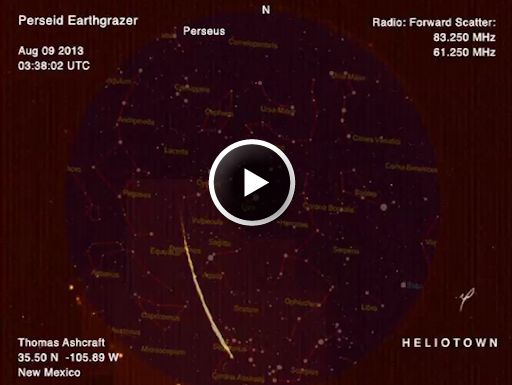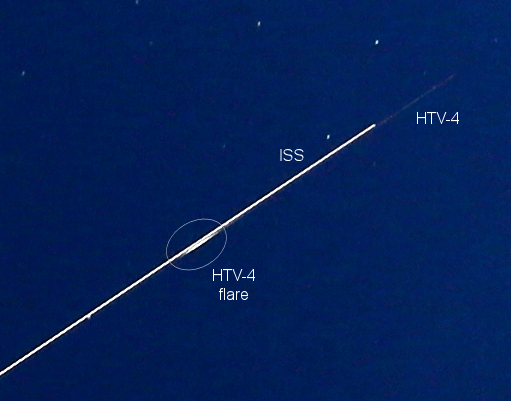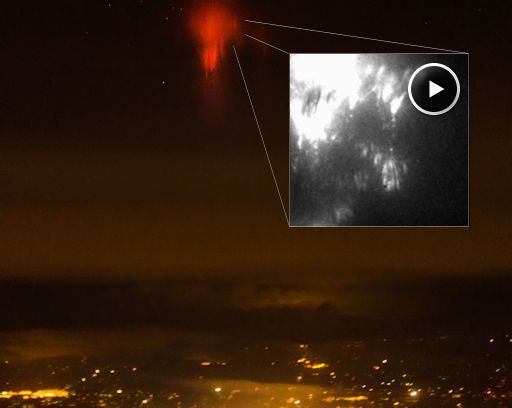They came from outer space--and you can have one! Genuine meteorites are now on sale in the Space Weather Store. | | |
CHANCE OF STORMS: NOAA forecastesrs estimate a 60% chance of polar geomagnetic storms on August 10th when one and perhaps two CMEs are expected to hit Earth's magnetic field. The incoming clouds were propelled from the sun by a flurry of erupting magnetic filaments on Aug. 6-7. High-latitude sky watchers should be alert for auroras. Aurora alerts: text, voice.
PERSEID EARTHGRAZER: Last night a bright meteor skimmed the top of Earth's atmosphere over rural New Mexico, passing almost directly above the private observatory of amateur astronomer Thomas Ashcraft. Wide-field cameras and radio receivers captured the flight of this Perseid earthgrazer:

Play the movie again and listen to the soundtrack. The eerie-sounding echoes are caused by terrestrial TV signals bouncing off the meteor's ionized trail. "In the radio meteor community, Perseids are known as 'blue whizzers' due to their fast speed and zinging radio reflections," notes Ashcraft.
More Earthgrazers are in the offing. Every night, Earth is plunging deeper into the debris stream of comet 109P/Swift-Tuttle, source of the annual Perseid meteor shower. The best time to look for earthgrazers is between 9:30 and 10:30 pm local time as the shower's radiant climbs over the northeastern horizon. That's when the geometry favors meteoroids skimming across the top of the atmosphere like a stone skipping across the surface of a pond. Earthgrazers are slow and colorful. (Regular non-Earthgrazing Perseids, on the other hand, are best seen after midnight.)
Forecasters expect the 2013 Perseid meteor shower to peak on the nights of August 12-13 with as many as ~100 meteors per hour. Stay tuned!
Realtime Meteor Photo Gallery
SPACE CHASE (Updated): On August 3rd, Japan launched a robotic spacecraft, the HTV-4, to re-supply the International Space Station (ISS). Last night, Larry Sloss saw the HTV-4 in hot pursuit of the ISS in the twilight skies over Priest Lake, Idaho:

"The HTV-4 was trailing the ISS by just 3 seconds," says Sloss.
Many observers noted "HTV-4 flares" this week. Apparently sunlight is glinting off a flat surface of the spacecraft, briefly raising its luminosity to match that of the much larger ISS. Sloss saw one too: "In the image, a brief, bright flare from the HTV-4 is slightly offset from the ISS trail."
HTV-4 has an interesting payload. Among the 5.4 tons of food, spare parts, and other supplies are Kirobo, a talking robot to join the crew of the ISS, and Firestation, an experiment to study mysterious Terrestrial Gamma-ray Flashes. Update: The HTV-4 docked to the space station at 11:38 EDT on Friday, Aug. 9th. Unloading has commenced.
Turn your smartphone into a field-tested ISS tracker: Download the Simple Flybys App.
Realtime Space Weather Photo Gallery
SPRITES AND JETS OVER OKLAHOMA CITY: High above Earth in the realm of meteors and noctilucent clouds, a strange form of lightning dances at the edge of space. Researchers call the bolts "sprites," and they are as beautiful as they are mysterious. Jason Ahrns, a graduate student from the University of Alaska Fairbanks, photographed a cluster of bright red sprites over Oklahoma City on August 6th. Click on the arrow to view a rare high-speed movie of the phenomenon:

"I normally study auroras," says Ahrns, "but I've become involved in sprites as a side interest." At the time of the photo, Ahrns was flying onboard a Gulfstream V operated by the National Center for Atmospheric Research (NCAR). "We try to get off to the side of sprite-producing storms, ideally about 200 km away, and film them with a couple of Phantom cameras running at 10,000 frames per second. One of the Phantoms has a diffraction grating in front of it to capture high speed spectra, which I don't think has ever been done before."
"We've also managed to record a few sprites over a lightning mapping array so we can identify the exact lightning strike that caused the sprite," he continues. "This has also never done before, and should provide insight into what type of lightning causes sprites."
"Lately," says Ahrns, "I've begun slipping my personal camera into a spare window of the airplane, and the results have been so impressive that we're planning to make a dSLR (digital camera) a regular part of future campaigns. On August 3rd I recorded some blue jets over Oklahoma city; I believe these are the first blue jets recorded by an ordinary dSLR." More tales of sprite-chasing may be found on Ahrns' personal blog.
Realtime Space Weather Photo Gallery
Realtime Aurora Photo Gallery
Realtime Noctilucent Cloud Photo Gallery
[previous years: 2003, 2004, 2005, 2006, 2007, 2008, 2009, 2011]
Realtime Comet Photo Gallery

